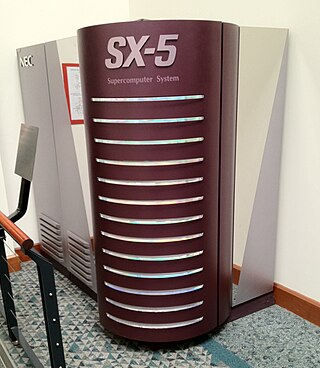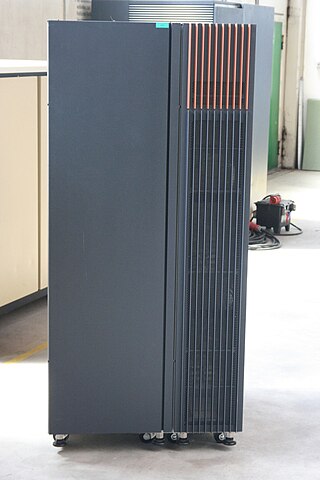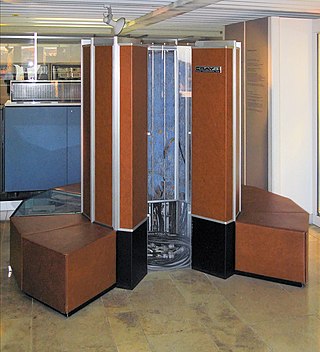
A supercomputer is a type of computer with a high level of performance as compared to a general-purpose computer. The performance of a supercomputer is commonly measured in floating-point operations per second (FLOPS) instead of million instructions per second (MIPS). Since 2022, supercomputers have existed which can perform over 1018 FLOPS, so called exascale supercomputers. For comparison, a desktop computer has performance in the range of hundreds of gigaFLOPS (1011) to tens of teraFLOPS (1013). Since November 2017, all of the world's fastest 500 supercomputers run on Linux-based operating systems. Additional research is being conducted in the United States, the European Union, Taiwan, Japan, and China to build faster, more powerful and technologically superior exascale supercomputers.

The Cray-1 was a supercomputer designed, manufactured and marketed by Cray Research. Announced in 1975, the first Cray-1 system was installed at Los Alamos National Laboratory in 1976. Eventually, eighty Cray-1s were sold, making it one of the most successful supercomputers in history. It is perhaps best known for its unique shape, a relatively small C-shaped cabinet with a ring of benches around the outside covering the power supplies and the cooling system.
Floating point operations per second is a measure of computer performance in computing, useful in fields of scientific computations that require floating-point calculations.

Blue Gene was an IBM project aimed at designing supercomputers that can reach operating speeds in the petaFLOPS (PFLOPS) range, with relatively low power consumption.

The ETA10 is a vector supercomputer designed, manufactured, and marketed by ETA Systems, a spin-off division of Control Data Corporation (CDC). The ETA10 was an evolution of the CDC Cyber 205, which can trace its origins back to the CDC STAR-100, one of the first vector supercomputers to be developed.
Cell, a shorthand for Cell Broadband Engine Architecture, is a 64-bit multi-core microprocessor and microarchitecture that combines a general-purpose PowerPC core of modest performance with streamlined coprocessing elements which greatly accelerate multimedia and vector processing applications, as well as many other forms of dedicated computation.

The SX-6 is a NEC SX supercomputer built by NEC Corporation that debuted in 2001; the SX-6 was sold under license by Cray Inc. in the U.S. Each SX-6 single-node system contains up to eight vector processors, which share up to 64 GB of computer memory. The SX-6 processor is a single chip implementation containing a vector processor unit and a scalar processor fabricated in a 0.15 μm CMOS process with copper interconnects, whereas the SX-5 was a multi-chip implementation. The Earth Simulator is based on the SX-6 architecture.
The VP2000 was the second series of vector supercomputers from Fujitsu. Announced in December 1988, they replaced Fujitsu's earlier FACOM VP Model E Series. The VP2000 was succeeded in 1995 by the VPP300, a massively parallel supercomputer with up to 256 vector processors.
The Fujitsu FACOM VP is a series of vector supercomputers designed, manufactured, and marketed by Fujitsu. Announced in July 1982, the FACOM VP were the first of the three initial Japanese commercial supercomputers, followed by the Hitachi HITAC S-810 in August 1982 and the NEC SX-2 in April 1983.

NEC SX describes a series of vector supercomputers designed, manufactured, and marketed by NEC. This computer series is notable for providing the first computer to exceed 1 gigaflop, as well as the fastest supercomputer in the world between 1992–1993, and 2002–2004. The current model, as of 2018, is the SX-Aurora TSUBASA.

The SX-8 is a supercomputer built by NEC Corporation. The SX-8 Series implements an eight-way SMP system in a compact node module and uses an enhanced version of the single chip vector processor that was introduced with the SX-6. The NEC SX-8 processors run at 2 GHz for vectors and 1 GHz for scalar operations. The SX-8 CPU operates at 16 GFLOPS and can address up to 128 GB of memory. Up to 8 CPUs may be used in a single node, and a complete system may have up to 512 nodes. The SX-8 series ranges from the single-CPU SX-8b system to the SX-8/4096M512, with 512 nodes, 4,096 CPUs, and a peak performance of 65 TFLOPS. There is up to 512 GB/s bandwidth per node. The SX-8 runs SUPER-UX, a Unix-like operating system developed by NEC.
ViVA is a technology from IBM for coupling together multiple scalar floating point units to act as a single vector processor. Certain computing tasks are more efficiently handled through vector computations where an instruction can be applied to multiple elements simultaneously, rather than the scalar approach where one instruction is applied to one piece of data at a time. This kind of technology is highly sought after for scientific computing and is IBM's answer to the vector-based supercomputers pioneered by Cray and that was the basis for NEC's Earth Simulator which was the fastest supercomputer in the world 2002-2004.
The HITAC S-810 is a family of vector supercomputers developed, manufactured and marketed by Hitachi. The S-810, first announced in August 1982, was the second Japanese supercomputer, following the Fujitsu VP-200 but predating the NEC SX-2. The S-810 was Hitachi's first supercomputer, although the company had previously built a vector processor, the IAP.
The HITAC S-3000 is a former family of vector supercomputers, which was developed, manufactured and marketed by Hitachi. Announced in April 1992, the family succeeded the HITAC S-820. The S-3000 family comprised the low-end and mid-range S-3600 models and the high-end S-3800 models. Unlike Hitachi's previous generations of supercomputers, the S-3000 family was marketed outside Japan.
Numerical Wind Tunnel (数値風洞) was an early implementation of the vector parallel architecture developed in a joint project between National Aerospace Laboratory of Japan and Fujitsu. It was the first supercomputer with a sustained performance of close to 100 Gflop/s for a wide range of fluid dynamics application programs. It stood out at the top of the TOP500 during 1993-1996. With 140 cores, the Numerical Wind Tunnel reached a Rmax of 124.0 GFlop/s and a Rpeak of 235.8 GFlop/s in November 1993.
The Hitachi SR2201 was a distributed memory parallel system that was introduced in March 1996 by Hitachi. Its processor, the 150 MHz HARP-1E based on the PA-RISC 1.1 architecture, solved the cache miss penalty by pseudo vector processing (PVP). In PVP, data was loaded by prefetching to a special register bank, bypassing the cache. Each processor had a peak performance of 300 MFLOPS, giving the SR2201 a peak performance of 600 GFLOPS. Up to 2048 RISC processors could be connected via a high-speed three-dimensional crossbar network, which was able to transfer data at 300 MB/s over each link.
Supercomputing in India has a history going back to the 1980s. The Government of India created an indigenous development programme as they had difficulty purchasing foreign supercomputers. As of November 2024, the AIRAWAT supercomputer is the fastest supercomputer in India, having been ranked 136th fastest in the world in the TOP500 supercomputer list. AIRAWAT has been installed at the Centre for Development of Advanced Computing (C-DAC) in Pune.

Japan operates a number of centers for supercomputing which hold world records in speed, with the K computer being the world's fastest from June 2011 to June 2012, and Fugaku holding the lead from June 2020 until June 2022.

The history of supercomputing goes back to the 1960s when a series of computers at Control Data Corporation (CDC) were designed by Seymour Cray to use innovative designs and parallelism to achieve superior computational peak performance. The CDC 6600, released in 1964, is generally considered the first supercomputer. However, some earlier computers were considered supercomputers for their day such as the 1954 IBM NORC in the 1950s, and in the early 1960s, the UNIVAC LARC (1960), the IBM 7030 Stretch (1962), and the Manchester Atlas (1962), all of which were of comparable power.
The PRIMEHPC FX10 is a supercomputer designed and manufactured by Fujitsu. Announced on 7 November 2011 at the Supercomputing Conference, the PRIMEHPC FX10 is an improved and commercialized version of the K computer, which was the first supercomputer to obtain more than 10 PFLOPS on the LINPACK benchmark. In its largest configuration, the PRIMEHPC FX10 has a peak performance 23.2 PFLOPS, power consumption of 22.4 MW, and a list price of US$655.4 million. It was succeeded by the PRIMEHPC FX100 with SPARC64 XIfx processors in 2015.







